The Intel Xeon W-3175X Review: 28 Unlocked Cores, $2999
by Ian Cutress on January 30, 2019 9:00 AM ESTIntel’s Prebuilt Test System: A $7000 Build
How we receive test units for review has varied greatly over the years. The company providing the review sample has a range of choices and hands-on solutions.
For a regular run of the mill launch, such as Kaby Lake/Coffee Lake/Coffee Lake gen 2, which are second generation launches on the same mature platform as the last generation, we get just the CPU and a set of ‘expected test result notes’ to help guide our testing. The reviewers are expected to know how to use everything and the vendor has confidence in the reviewers analysis. This method allows for the widest range of sampling and the least work at the vendor level, although relies on the journalist to have the relevant contacts with motherboard and memory companies as well as the ability to apply firmware updates as needed.
For important new launches, such as Ryzen and AM4, or Threadripper and TR4, or Skylake-X and X299, the vendor supplied the CPU(s), a motherboard, a memory kit, and a suitable CPU cooler. Sometimes there’s a bit of paper from the FAE tester that confirmed the set worked together over some basic stress tests, but it puts less work in the hands of the reviewer knowing that none of the kit should be dead on arrival and it should at least get to the OS without issue.
For unique launches, where only a few samples are being distributed, or there is limited mix-and-match support ready for day one, the option is the full system sample. This means case, motherboard, CPU, CPU cooler, memory, power supply, graphics card, and storage are all shipped as one, sometimes directly from a system integrator partner, but with the idea that the system has been pre-built, pre-tested, and ready to go. This should give the reviewer the least amount of work to do (in practice it’s usually it’s the opposite), but it puts a lot of emphasis on the vendor to plan ahead, and limits the scope of sampling. It also the most expensive for the vendor to implement, but usually the tradeoff is perceived as worth it.
Usually we deal with options one or two for every modern platform to date. Option three is only ever taken if the CPU vendor aims to sell the processor to OEMs and system integrators (SI) only. This is what Intel has done with the Xeon W-3175X, however they built the systems internally rather than outsourcing. After dispatch from the US to the UK, via the Netherlands, an 80 lb (36 kg) box arrived on my doorstep.
This box was huge. I mean, I know the motherboard is huge, I’ve seen it in the flesh several times, but Intel also went and super-sized the system too. This box was 33 inches tall (84 cm), and inside that was a set of polystyrene spacers for the actual box for the case, which again also had polystyrene spacers. Double spacey.
Apologies for taking these photos in my kitchen – it is literally the only room in my flat in which I had enough space to unbox this thing. Summer wanted to help, and got quite vocal.
The case being used is the Anidees AI Crystal XL AR, listed on the company’s website as ‘all the space you need for your large and heavy loaded components’, including support for HPTX, XL-ATX, E-ATX, and EEB sized motherboards, along with a 480mm radiator on top and a 360mm radiator on front, and comes with five 120mm RGB fans as standard. It’s a beast, surrounded with 5mm tempered glass on every side that needs it.
The case IO has a fan control switch (didn’t work), two audio jacks, an LED power button, a smaller LED reset button, two USB 3.0 Type-A ports, and two USB 2.0 Type-A ports. These were flush against the design making for a very straight edged design.
This picture might show you how tall it is. Someone at Intel didn’t install the rear IO plate leaving an air gap, but actually the system airflow was designed for the rear of the chassis to be the intake and the front of the chassis to be the exhaust. There are 10 PCIe slot gaps here, along with two vertical ones for users that want to mount in that way. There is sufficient ‘case bezel’ on all sides, unlike some smaller cases that minimize this.
Users may note the power supply has an odd connector. This is a C19 connecter usually used for high-wattage power supplies, and strapped to the box Intel had supplied a power cable.
This bad boy is thick. Ignoring the fact that this is a US cable and the earth pin is huge to the extent that it would only fit in one of my adaptors and even nudging the cable caused the machine to restart so I had to buy a UK cable that worked great, this unit is designed for the low voltage US market it seems. It has to be able to deliver up to 13A of current on a 120V line, or potentially more, so is built as such. With this it is obviously recommended that no socket extenders are used and this goes directly into the wall.
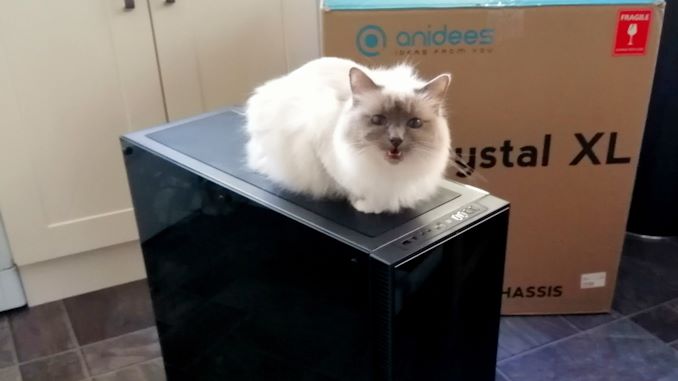
About to take the side panels off. This little one wants to play.
Both of the tempered glass side panels are held on by nine thumb screws each, which sit on rubber stands on the inside of the case. Unscrewing these was easy enough to do, however it’s one of the slowest ways to open a case I’ve ever come across.
Now inside the system at hand. The LGA3647 socket holds the Xeon W-3175X processor, which is capped with an Asetek 690LX-PN liquid cooler specifically designed for the workstation market. This goes to a 360mm liquid cooling radiator, paired with three high power (I’m pretty sure they’re Delta) fans that sound like a jet engine above 55ºC.
Intel half populated the memory with 8GB Samsung DDR-2666 RDIMMs, making for a total of 48 GB of memory, which is likely going to be the lowest configuration one of these CPUs will ever be paired with. The graphics card is a GIGABYTE GTX 1080, specifically the GV-N1080TTOC-8GD, which requires one 8-pin power connector.
For the motherboard, the ASUS Dominus Extreme, we’ve detailed it in previous coverage, however it’s worth to note that the big thing at the top of this motherboard is actually the heatsink for the 32-phase VRM. It’s a beast. Here is an ASUS build using this motherboard with a liquid cooler on the CPU and VRM:
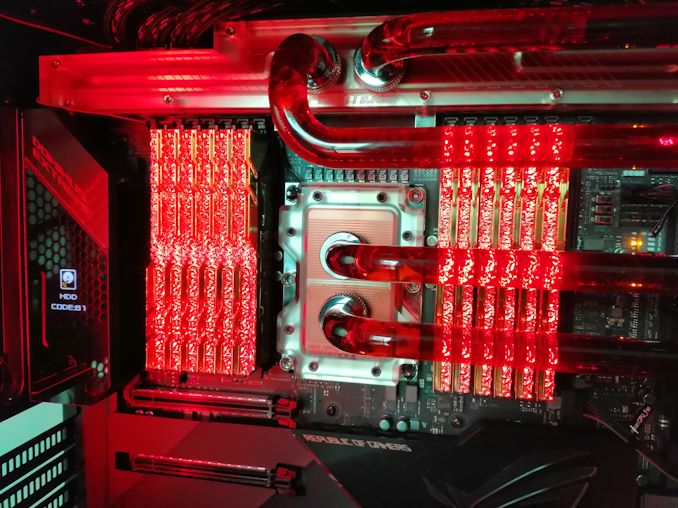
The build at ASUS’ suite at CES 2019
There’s a little OLED display to the left, which as a full color display useful for showing BIOS codes and CPU temperatures when in Windows. When the system is off, it goes through a short 15 second cycle with the logo:
I’m pretty sure users can put their own gifs (perhaps within some limits) on the display during usual run time using ASUS software.
The rear of the case is quite neat, showing part of the back of the motherboard and the fan controller. At the bottom we have an EVGA 1600W T2 80PLUS Titanium power supply, which is appropriate for this build. Unfortunately Intel only supplied the cables that they actually used with the system, making it difficult to expand to multiple GPUs, which is what a system like this would ultimately end up with.
For storage, Intel provided an Optane 905P 480GB U.2 drive, which unfortunately had so many issues with the default OS installation (and then failing my own OS installation) that I had to remove it and debug it another day. Instead I put in my own Crucial MX200 1TB SATA SSD which we normally use for CPU testing and installed the OS directly on that. ASUS has a feature in the BIOS that will automatically push a software install to initiate driver updates without the need for a driver DVD – this ended up being very helpful.
Overall, the system cost is probably on the order of $7000:
| Intel Reference System | ||
| Item | List Price | |
| CPU | Intel Xeon W-3175X | $2999 |
| CPU Cooler | Asetek 690LX-PN | $260 |
| Motherboard | ASUS Dominus Extreme | $1500 ? |
| Memory | 6 x 8GB Samsung DDR4-2666 RDIMM | $420 |
| Storage | Intel Optane 905P 480 GB U.2 | $552 |
| Video Card | GIGABYTE GTX 1080 OC 8GB | $550 |
| Chassis | Anidees AI Crystal XL AR | $300 |
| Power Supply | EVGA 1600W T2 Titanium | $357 |
| Total | $6938 | |
However, this is with a minimum amount of memory, only one GTX 1080, and a mid-sized U.2 drive. If we add in liquid cooling, a pair of RTX 2080 Ti graphics cards, 12x16GB of DDR4, and some proper storage, the price could easily creep over $10k-$12k, then add on the system builder additions. The version of this system we saw at the Digital Storm booth at CES, the Corsa, was around $20k.



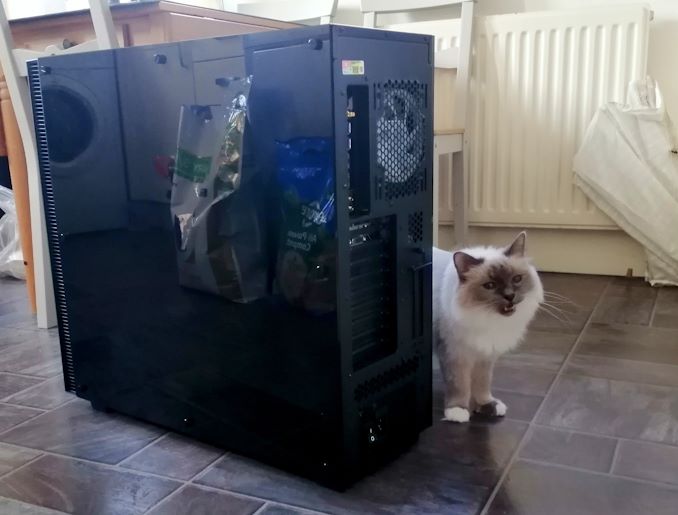
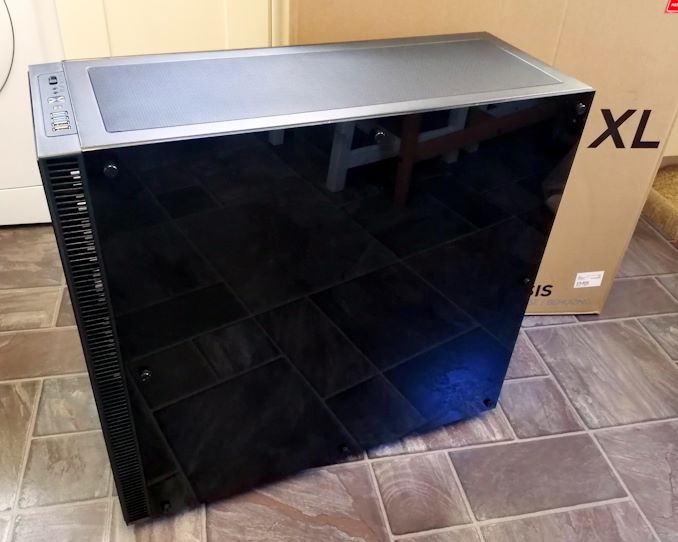
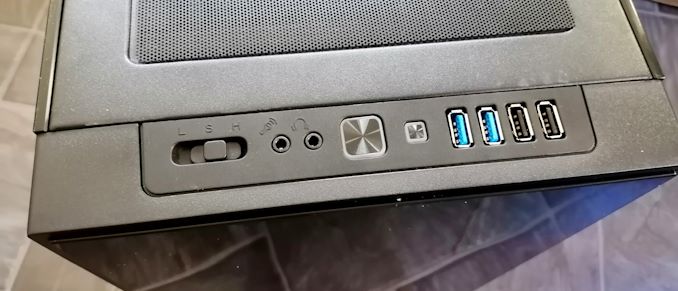
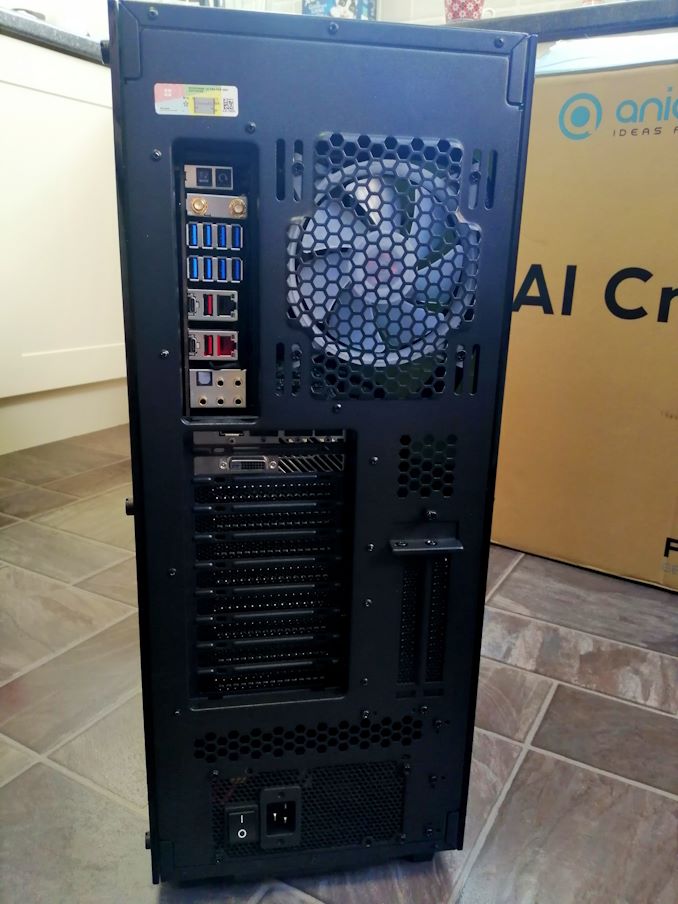
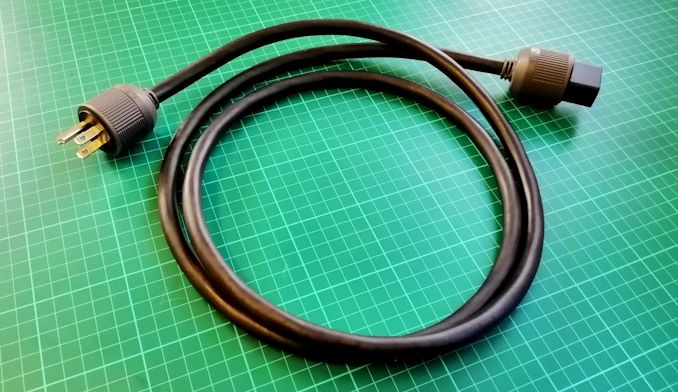
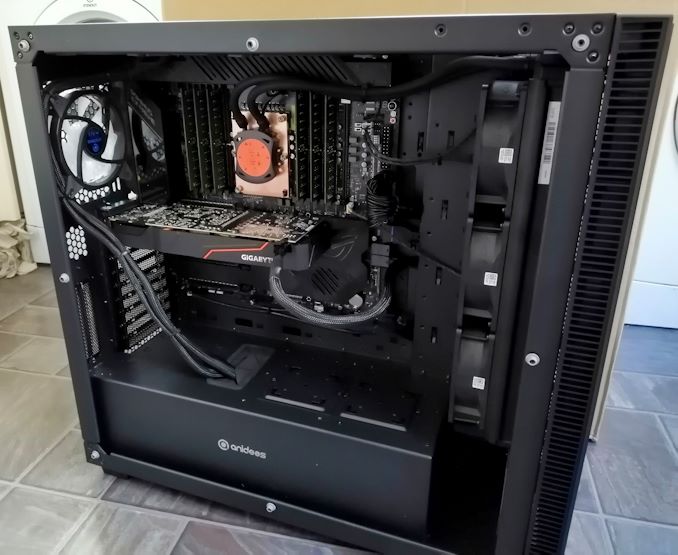
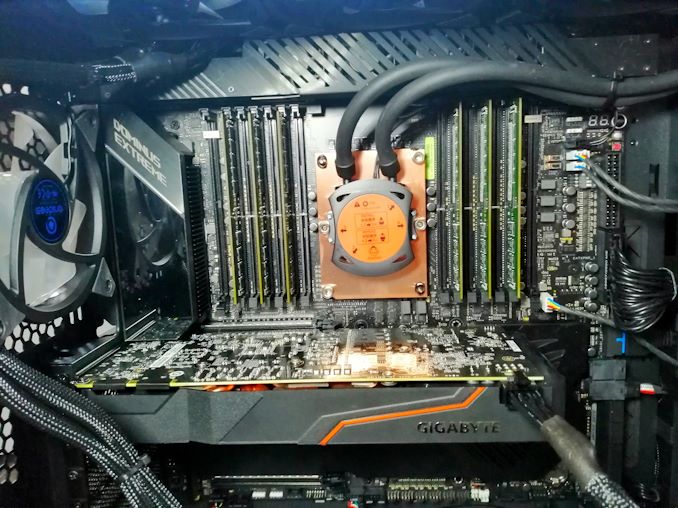

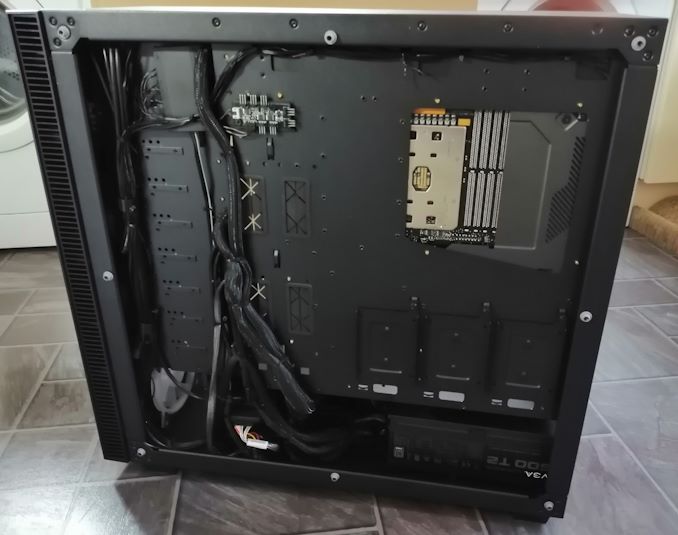
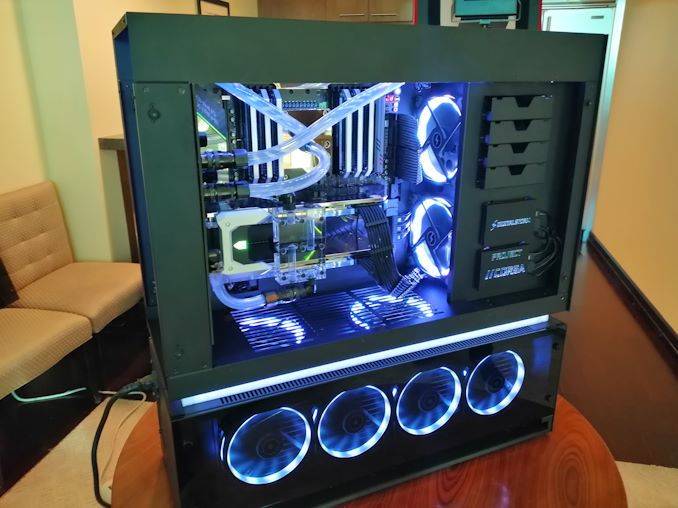








136 Comments
View All Comments
Kevin G - Wednesday, January 30, 2019 - link
For $3000 USD, a 28 core unlocked Xeon chip isn't terribly bad. The real issue is its incredibly low volume nature and that in effect only two motherboards are going to be supporting it. LGA 3647 is a wide spread platform but the high 255W TDP keeps it isolated.Oddly I think Intel would have had better success if they also simultaneously launched an unlocked 18 core part with even higher base/turbo clocks. This would have threaded the needle better in terms of per thread performance and overall throughput. The six channel memory configuration would have assisted in performance to distinguish itself from the highend Core i9 Extreme chips.
The other aspect is that there is no clear upgrade path from the current chips: pretty much one chip to board ratio for the life time of the product. There is a lot on the Xeon side Intel has planned like on package FGPAs, Omnipath fabric and Nervana accelerators which could stretch their wings with a 255 W TDP. The Xeon Gold 6138P is an example of this as it comes with an Arria 10 FPGA inside but a slightly reduced clock 6138 die as well at a 195 W TDP. At 255 W, that chip wouldn't have needed to compromise the CPU side. For the niche market Intel is targeting, a FPGA solution would be interesting if they pushed ideas like OpenCL and DirectCompute to run on the FPGA alongside the CPU. Doing something really bold like accelerating PhysX on the FPGA would have been an interesting demo of what that technology could do. Or leverage the FGPA for DSP audio effects in a full 3D environment. That'd give something for these users to look forward to.
Well there is the opportunity to put in other LGA 3647 parts into these boards but starting off with a 28 core unlocked chip means that other offering are a downgrade. With luck, Ice Lake-SP would be an upgrade but Intel hasn't committed to it on LGA 3647.
Ultimately this looks like AMD's old 4x4/QuadFX efforts that'll be quickly forgotten by history.
Speaking of AMD, Intel missing the launch window by a few months places it closer to the eminent launch of new Threader designs leveraging Zen 2 and AMD's chiplet strategy. I wouldn't expect AMD to go beyond 32 cores for Threadripper but the common IO die should improve performance overall on top of the Zen 2 improvements. Intel has some serious competition coming.
twtech - Wednesday, January 30, 2019 - link
Nobody really upgrades workstation CPUs, but it sounds like getting a replacement in the event of failure.could be difficult if the stock will be so limited.If Dell and HP started offering this chip in their workstation lineup - which I don't expect to happen given the low-volume CPU production and needing a custom motherboard - then I think it would have been a popular product.
DanNeely - Wednesday, January 30, 2019 - link
Providing the replacement part (and thus holding back enough stock to do so) is on Dell/HP/etc via the support contract. By the time it runs out in a few years the people who buy this sort of prebuilt system will be upgrading to something newer and much faster anyway.MattZN - Wednesday, January 30, 2019 - link
I have to disagree re: upgrades. Intel has kinda programmed consumers into believing that they have to buy a whole new machine whenever they upgrade. In the old old days we actually did have to upgrade in order to get better monitor resolutions because the busses kept changing.But in modern times that just isn't the case any more. For Intel, it turned into an excuse to get people to pay more money. We saw it in spades with offerings last year where Intel forced people into a new socket for no reason (a number of people were actually able to get the cpu to work in the old socket with some minor hackery). I don't recall the particular CPU but it was all over the review channels.
This has NOT been the case for Intel's commercial offerings. The Xeons traditionally have had a whole range of socket-compatible upgrade options. It's Intel's shtick 'Scaleable Xeon CPUs' for the commercial space. I've upgraded several 2S Intel Xeon systems by buying CPUs on E-Bay... its an easy way to double performance on the cheap and businesses will definitely do it if they care about their cash burn.
AMD has thrown cold water on this revenue source on the consumer side. I think consumers are finally realizing just how much money Intel has been squeezing out of them over the last decade and are kinda getting tired of it. People are happily buying new AMD CPUs to upgrade their existing rigs.
I expect that Intel will have to follow suit. Intel traditionally wanted consumers to buy whole new computers but now that CPUs offer only incremental upgrades over prior models consumers have instead just been sticking with their old box across several CPU cycles before buying a new one. If Intel wants to sell more CPUs in this new reality, they will have to offer upgradability just like AMD is. I have already upgraded two of my AM4 boxes twice just by buying a new CPU and I will probably do so again when Zen 2 comes out. If I had had to replace the entire machine it would be a non-starter. But since I only need to do a BIOS update and buy a new CPU... I'll happily pay AMD for the CPU.
Intel's W-3175X is supposed to compete against threadripper, but while it supposedly supports ECC I do not personally believe that the socket has any longevity and that it is a complete waste of money and time to buy into it verses buying into threadripper's far more stable socket and far saner thermals. Intel took a Xeon design that is meant to run closer to the maximally efficient performance/power point on the curve and tried to turn it into a pro-sumer or small-business competitor to the threadripper by removing OC limits and running it hot, on an unstable socket. No thanks.
-Matt
Kevin G - Thursday, January 31, 2019 - link
I would disagree with this. Workstations around here are being retrofitted with old server hand-me-downs from the data center as that requipment is quietly retired. Old workstations make surprisingly good developer boxes, especially considering that the costs is just moving parts from one side of the company to the other.Though you do have point that the major OEMs themselves are not offering upgrades.
drexnx - Wednesday, January 30, 2019 - link
wow, I thought (and I think many people did) that this was just a vanity product, limited release, ~$10k price, totally a "just because we're chipzilla and we can" type of thinglooks like they're somewhat serious with that $3k price
MattZN - Wednesday, January 30, 2019 - link
The word 'nonsensical' comes to mind. But setting aside the absurdity of pumping 500W into a socket and trying to pass it off as a usable workstation for anyone, I have to ask Anandtech ... did you run with the scheduler fixes necessary to get reasonable results out of the 2990WX in the comparisons? Because it kinda looks like you didn't.The Windows scheduler is pretty seriously broken when it comes to both the TR and EPYCs and I don't think Microsoft has pushed fixes for it yet. That's probably what is responsible for some of the weird results. In fact, your own article referenced Wendel's work here:
https://www.anandtech.com/show/13853/amd-comments-...
That said, of course I would still expect this insane monster of Intel's to put up better results. It's just that... it is impractical and hazardous to actually configure a machine this way and expect it to have any sort of reasonable service life.
And why would Anandtech run any game benchmarks at all? This is a 28-core Xeon... actually, it's two 14-core Xeons haphazardly pasted together (but that's another discussion). Nobody in their right mind is going to waste it by playing games that would run just as well on a 6-core cpu.
I don't actually think Intel has any intention of actually selling very many of these things. This sort of configuration is impractical with 14nm and nobody in their right mind would buy it with AMD coming out with 10nm high performance parts in 5 months (and Intel probably a bit later this year). Intel has no business putting a $3000 price tag on this monster.
-Matt
eddman - Thursday, January 31, 2019 - link
"it's two 14-core Xeons haphazardly pasted together"Where did you get that info? Last time I checked each xeon scalable chip, be it LCC, HCC or XCC, is a monolithic die. There is no pasting together.
eddman - Thursday, January 31, 2019 - link
Didn't you read the article? It's right there: "Now, with the W-3175X, Intel is bringing that XCC design into the hands of enthusiasts and prosumers."Also, der8auer delidded it and confirmed it's an XCC die. https://youtu.be/aD9B-uu8At8?t=624
mr_tawan - Wednesday, January 30, 2019 - link
I'm surprised you put the Duron 900 on the image. That makes me expecting the test result from that CPU too!!